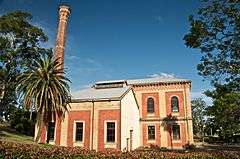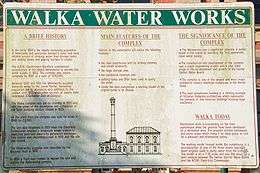Walka Water Works
| Walka Water Works | |
|---|---|
 The pump house and smoke stack | |
| General information | |
| Architectural style | Victorian Italianate |
| Location | Oakhampton Heights |
| Address |
55 Scobies Lane Oakhampton Heights NSW 2320 |
| Town or city | Maitland, New South Wales |
| Country | Australia |
| Coordinates | 32°42′54.6″S 151°33′8.7″E / 32.715167°S 151.552417°ECoordinates: 32°42′54.6″S 151°33′8.7″E / 32.715167°S 151.552417°E |
| Construction started | 1882 |
| Completed | 1887 |
| Cost | £170,000 |
| Client | Government of New South Wales |
| Technical details | |
| Structural system | Brick |
Walka Water Works is a 19th-century pumping station located near Maitland, New South Wales, Australia. Originally built in 1887 to supply water to Newcastle and the lower Hunter Valley, it has since been restored and preserved and is part of Maitland City Council's Walka Recreation and Wildlife Reserve.
History
Waterworks
During the early 1880s, with a growing population in Newcastle, the NSW Government commenced construction of the Walka Waterworks to provide a safer water supply to the Newcastle, Maitland, Morpeth and Cessnock districts than existing storage tanks, creeks and boreholes.[1] It was largely complete by 1887 at a cost of £170,000.

The design for the complex was undertaken by notable English engineer Sir William Clark and was a major engineering project for the area at the time.[2] Water was pumped from the Hunter River to a reservoir along a brick tunnel approximately 6 feet (1.8 m) in diameter and 9 metres (30 ft) below ground.[2][3] At full operation, it had three pumping engines (150 hp each and with a flywheel weighing 36 tonnes), two horizontal compound pumps and a triple expansion surface condensing pump engine.[2] Water would be pumped from the river at Oakhampton up to the Walka reservoir (still visible as the Walka lake today), then pumped onwards to another reservoir 6 miles (9.7 km) away at Buttai; where it was "gravitationally distributed".[1]
At peak operation the waterworks produced 3843 megalitres (in 1915).[1] As the population of the area continued to increase, alterations and additions were made to the system until 1913, when other sources of supply were developed - namely Chichester Dam near Dungog. From 1923 to 1940 the waterworks were used as a backup water supply only.[1]
In 1925 the complex was put on standby and with the onset of the great depression and the completion of Tarro pumping station at Tarro, the plant was closed in 1929. After the Second World War in 1949 all the plant and machinery was sold for scrap, fetching £2,500.
Power Station
Two years later, in 1951, the site was reopened as a temporary coal power station by the Electricity Commission to overcome post-war electricity shortages. What was described as a "package power plant" was bought from General Electric and imported from America. The plant was shipped out in pieces, then taken to the site by rail (to Maitland station) and a specially made truck. GE engineers also came out to assemble the plant.[4]
It began producing electricity in 1953. Three boilers ran on coal, and another ran on oil, though later this became a coal/oil combination. Two rail lines were built to the power station from the North Coast railway line.[5]
Using Walka as a power station was controversial. Initially the power station suffered from sinking foundations - leading to the temporary sacking of 120 workers, until it was agreed that the sinking was a result of recent rain.[6] During construction, the workforce went on strike after a boilermaker union member was sacked for "misconduct" towards his foreman.[7] This was eventually resolved, but in December 1953 the power station suffered another setback when one of its oil storage tanks collapsed in gale force winds. The station was also unpopular with local vegetable growers, who complained about the amount of soot the station was producing.[5]
This station was eventually decommissioned in 1978 and the site was closed.
Recreation and Wildlife Reserve
Not until 1984 were there definite attempts to reopen the site. At this time a Trust was formed, aiming to open the site and restore the Waterworks complex. The complex had been classified by the National Trust in 1976. Today the area is open as a free public reserve, with barbecues, picnics areas, a playground, walking trails and a 7 1/4 inch gauge miniature railway that operates passenger rides each Sunday. The reservoir and surrounding plant life make it a unique environment for birds and animals in the area.
Key characteristics

- Main pump house with distinctive chimney, ornate brickwork and Victorian Italianate architecture
- Large sandstone water reservoir
- Settling tanks and filter beds to purify water
- Miniature Railway
References
- 1 2 3 4 George, Peter (1997). The Walka Power Station 1953-1977. Bolwarra, NSW: self published. p. 1. External link in
|publisher=(help) - 1 2 3 Walsh, Brian; Archer, Cameron (2007). Maitland on the Hunter (2nd ed.). Tocal, NSW: CB Alexander Foundation. pp. 92–93. ISBN 0-7313-0596-5.
- ↑ "The Lower Hunter Water-Works". The Maitland Mercury, and Hunter River General Advertiser. 22 December 1881. p. 6. Retrieved 4 April 2009.
- ↑ George, P p2
- 1 2 George, P p9
- ↑ George, P p5
- ↑ George, P p7
- Information board at Walka Water Works (see image)
External links
- Maitland City Council - Walka Recreation and Wildlife Reserve
- Walka Water Works Restoration - 07/03/2006 - QWN - NSW Parliament